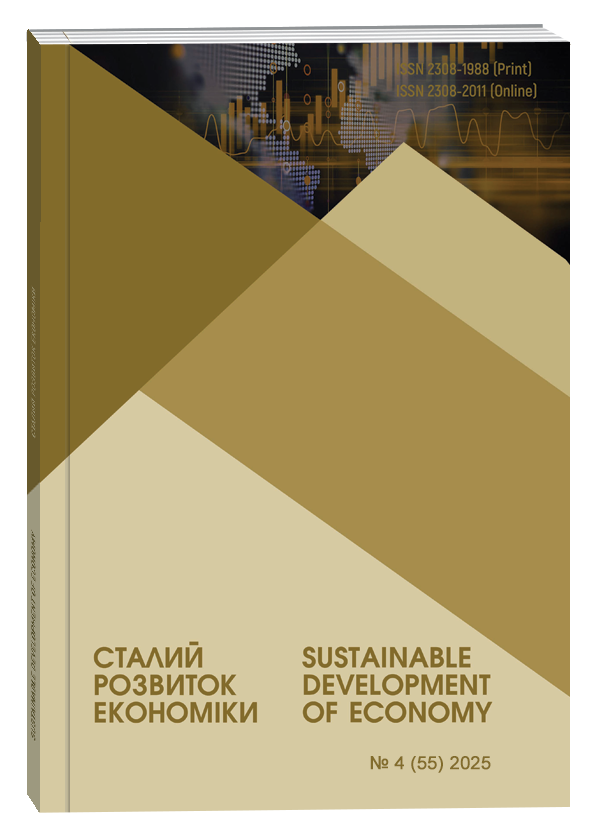ECONOMIC SECURITY THROUGH NONLINEAR DYNAMICS: ATTRACTORS, PERSISTENCE, AND EARLY SIGNALS
Abstract
This paper develops a compact workflow for macroeconomic risk assessment grounded in nonlinear dynamics. Motivated by the instability of linear forecasts under structural breaks, we combine two minimally data-hungry tools: (i) phase analysis via return maps (x_t,x_(t+1) ) building on Takens’ embedding intuition to visualise local structure and regime shifts; (ii) the Hurst exponent H, estimated using classical rescaled-range statistics, to quantify long-memory and persistence. The empirical design uses annual World Bank series for real GDP, consumer-price inflation, and nominal exchange rates and covers Ukraine, Argentina, Venezuela, Turkey, and Germany, alongside benchmark advanced economies. To ensure comparability we normalize levels, compute growth rates where appropriate, and plot figures preserving relative scaling (including log–log axes when dispersion spans orders of magnitude). Three regularities emerge. First, in Germany the GDP portraits cluster near the 45-degree line, consistent with near-linear local dynamics and modest noise. Second, for inflation and exchange rates in shock-prone economies (Ukraine, Turkey, Argentina, Venezuela) the clouds are widely dispersed and exhibit scale-invariant patterns compatible with multiplicative mechanisms and power-law variability; several segments look chaotic in the return-map sense. Third, H typically exceeds 0.5 for inflation and exchange rates, indicating persistence and a higher probability of multi-period runs, whereas for GDP growth it is close to 0.5, implying weaker memory. Taken together, these diagnostics help separate tranquil and turbulent regimes, provide early warnings of transitions, and summarise the strength and duration of shocks. Policy relevance is twofold. First, the workflow offers fast visual triage: a simple two-dimensional portrait flags regime changes before standard residual tests react. Second, the Hurst metric supports calibration of risk buffers and stress scenarios in economic-security applications, especially where measurement breaks and limited samples undermine conventional inference. Methodologically, the approach is transparent and robust to short or noisy series: it requires only consecutive observations, handles gaps gracefully, and can be deployed for cross-country surveillance. The evidence suggests that integrating nonlinear diagnostics with traditional models improves monitoring of macroeconomic risks and the identification of crisis phenomena, without demanding large panels or restrictive parametric assumptions.
References
Hurst H. E. Long-Term Storage Capacity of Reservoirs. Transactions of the American Society of Civil Engineers. 1951. Vol. 116. P. 770–799. DOI: https://doi.org/10.1061/TACEAT.0006518
Kříž R. Chaotic analysis of the GDP time series. Nostradamus 2013: Prediction, Modeling and Analysis of Complex Systems. Advances in Intelligent Systems and Computing. Cham: Springer, 2013. Vol. 210. P. 353–362. DOI: https://doi.org/10.1007/978-3-319-00542-3_36
Santos E. Regional Disparities in Inflation Persistence: Unpacking the Dynamics of Price Growth in Portugal. Economic Analysis Letters. 2023. № 2(3). P. 45–53. DOI: https://doi.org/10.58567/eal02030006
Takens F. Detecting Strange Attractors in Turbulence. Lecture Notes in Mathematics. Berlin: Springer, 1981. Vol. 898. P. 366–381.
Theiler J., Eubank S., Longtin A., Galdrikian B., Farmer J. D. Testing for Nonlinearity in Time Series: The Method of Surrogate Data. Physica D: Nonlinear Phenomena. 1992. Vol. 58. P. 77–94. DOI: https://doi.org/10.1016/0167-2789(92)90102-S
Werner A. Outlook for the Americas: A Tougher Recovery. IMF Blog. 23.07.2018. URL: https://www.imf.org/en/Blogs/Articles/2018/07/23/blog-outlook-for-the-americas-a-tougher-recovery
Грабчук О. М. Прогнозування рівня інфляції в Україні: індетерміністський погляд. Економічний вісник Дніпровської політехніки. 2020. № 3. С. 27–34. DOI: https://doi.org/10.33271/ebdut/71.027
Кладченко І. С. Фазовий портрет динаміки розвитку національної економіки. Бізнес Інформ. 2017. № 1. С. 79–88.
Книшенко Т. М.; Гізатулін А. М. Виявлення зони атракції в економічній системі на основі оцінювання форм розподілу показників структурних елементів. Ефективна економіка. 2014. № 4. URL: http://www.economy.nayka.com.ua/?op=1&z=2943 (дата звернення: 12.08.2025).
Світовий банк. World Development Indicators: FP.CPI.TOTL.ZG Inflation, consumer prices (annual %). URL: https://data.worldbank.org/indicator/FP.CPI.TOTL.ZG (дата звернення: 12.08.2025).
Скалозуб В. В.; Клименко І. В. Розвиток процедур аналізу та прогнозування недетермінованих технолого-економічних процесів на основі показників хаотичної динаміки. Економіка: реалії часу. 2016. № 4(26). С. 149–154.
Hurst, H. E. (1951). Long-term storage capacity of reservoirs. Transactions of the American Society of Civil Engineers. vol. 116, pp. 770–799. DOI: https://doi.org/10.1061/TACEAT.0006518
Kříž, R. (2013). Chaotic analysis of the GDP time series. In I. Zelinka (Ed.), Nostradamus 2013: Prediction, Modeling and Analysis of Complex Systems. Advances in Intelligent Systems and Computing. vol. 210, pp. 353–362. DOI: https://doi.org/10.1007/978-3-319-00542-3_36
Santos, E. (2023). Regional disparities in inflation persistence: Unpacking the dynamics of price growth in Portugal. Economic Analysis Letters. vol. 2(3), pp. 45–53. DOI: https://doi.org/10.58567/eal02030006
Takens, F. (1981). Detecting strange attractors in turbulence. In D. A. Rand & L.-S. Young (Eds.), Lecture Notes in Mathematics. vol. 898, pp. 366–381.
Theiler, J., Eubank, S., Longtin, A., Galdrikian, B., & Farmer, J. D. (1992). Testing for nonlinearity in time series: The method of surrogate data. Physica D: Nonlinear Phenomena. vol. 58, pp.77–94. DOI: https://doi.org/10.1016/0167-2789(92)90102-S.
Werner, A. (2018, July 23). Outlook for the Americas: A tougher recovery. IMF Blog. URL: https://www.imf.org/en/Blogs/Articles/2018/07/23/blog-outlook-for-the-americas-a-tougher-recovery
Hrabchuk O. M. (2020). Prohnozuvannia rivnia infliatsii v Ukraini: indeterministskyi pohliad [Forecasting the inflation level in Ukraine: The indeterministic view]. Ekonomichnyi Visnyk Dniprovskoi Politekhniky [Economic Bulletin of Dnipro University of Technology]. vol. 3, pp. 27–34. — DOI: https://doi.org/10.33271/ebdut/71.027 (in Ukrainian)
Kladchenko, I. S. (2017). Fazovyi portret dynamiky rozvytku natsionalnoi ekonomiky [Phase portrait of the dynamics of the national economy]. Biznes Inform - Business Inform. vol. 1, pp. 79–88. (in Ukrainian)
Knyshenko, T. M., Hizatulin, A. M. (2014). Vyiavlennia zony atraktsii v ekonomichnii systemi na osnovi otsiniuvannia form rozpodilu pokaznykiv strukturnykh elementiv [Identification of the attraction zone in an economic system based on distribution-form assessment]. Efektyvna Ekonomika - Effective Economics, vol. 4. Available at: http://www.economy.nayka.com.ua/?op=1&z=2943 (in Ukrainian)
World Bank. (2025). World Development Indicators. Inflation, consumer prices (annual %) [FP.CPI.TOTL.ZG]. Available at: https://data.worldbank.org/indicator/FP.CPI.TOTL.ZG
Skalozub, V. V., & Klymenko, I. V. (2016). Rozvytok protsedur analizu ta prohnozuvannia nedeterminovanykh tekhnoloho-ekonomichnykh protsesiv na osnovi pokaznykiv khaotychnoi dynamiky [Development of analysis and forecasting procedures for non-deterministic techno-economic processes based on chaotic-dynamics indicators]. Ekonomika: Realii Chasu - Economics: Realities of the times, vol. 4(26), pp. 149–154. (in Ukrainian)


